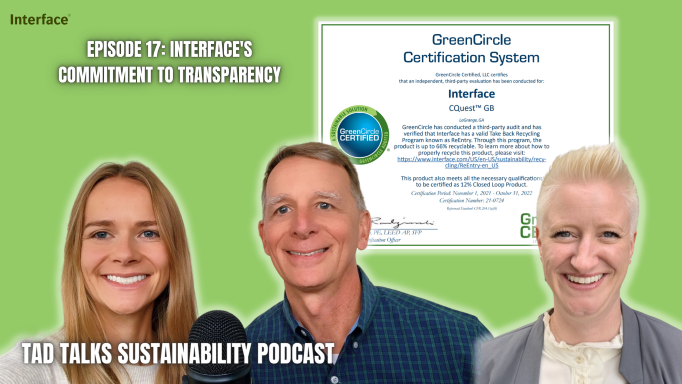Episode 17: Reversing Global Warming and Creating Carbon Negative Products with Lisa Conway from Interface
Click the links below to listen to the full episode
Climate change is a significant issue for everyone on the planet. Reducing embodied and operational carbon is critical to reversing global warming. In this episode, Tad and Julianna sit down with Lisa Conway VP of Sustainability, Americas for Interface, to discuss Interface’s commitment to sustainability, why carbon is so important in the building industry, Interface’s carbon neutral and negative products for carpet and Luxury Vinyl Tile (LVT), Interface’s GreenCircle certifications, and what’s next for embodied carbon in products.
Why is carbon so important in the flooring industry?
“Yeah, it's important in the building industry, right? I mean, carpet is just a piece of that. Flooring is just a piece of that. It's really important though, because it cycles out so often and because of all the things that can go into an interior. Flooring ranks in the top three for highest carbon footprint in the building industry. And the main driver of that in carpet is the nylon. Nylon is extremely energy intensive to produce. Most of the nylon that's used in flooring is virgin nylon. So what we realized early on from doing life cycle analysis is that the hotspot for carpet specifically is the nylon face. The rest of the process still matters, for example using renewable energy and manufacturing matters. The backing being recycled or bio based matters, but that nylon. When we moved to recycled nylon that deeply drove our carbon footprint down. The issue was that nobody cared at the time. No one was using that as a lens for decision making criteria and we're starting to see that emerge. All that cycling out is just more and more greenhouse gases associated with making all those products.”
Interface has come out with carbon neutral and carbon negative products, tell us more about these product innovations for carpet?
“So the most important thing of course is to drive down the embodied carbon of all the stuff that we make. Since 2003, we've actually been purchasing offsets that equate to the entire life cycle of our products and offering them as carbon neutral. So that started with carpet, which as you know, is where we started. But now people don't even realize we have LVT. We have final sheet, we have rigid core LVT, and we have Nora rubber. So for all of our products and now globally, not just in the Americas, we purchase offsets for any part of that carbon footprint that we can't reduce. And then we even buy offsets for the rest of the life cycle after it leaves our dock that account for people vacuuming or cleaning them.
So that has been a standing program for a long time for us. What was really neat back in 2020, we launched the world's first carbon negative carpet tile. That claim is based on cradle to gate or as you know, raw material extraction through manufacturing. So it kind of turns on its head, the idea that we shouldn't be buying materials. I mean, using less is definitely a good thing to go by, but a lot of people use soft flooring for a lot of reasons. This podcast wouldn't be going as well if we weren't on carpet. So people are buying it anyway and it actually stores more carbon then was emitted to make the product.
So it's okay to buy carpet, and we can feel good about buying it. So that has been a really exciting innovation for us, and that has really been based on a few things. One is the use of biobased materials. So plants absorb CO2 through photosynthesis, and then we interrupt that carbon cycle and store them in products. In addition to a different type of manufacturing process that we're using. It was the largest investment in Interface history to create our CQuest™ backings line. CQuest™ is C for carbon and then quest. for sequester carbon, kind of super nerdy. So I think it's three styles right now that are standard as carbon negative, but I think it just bodes well for the industry. You guys are used to so many varied products that you certify and different types of manufacturers that you work with. I think if you can take something that's not like a hundred percent natural material and still make it carbon negative, that's like a real moonshot for manufacturers that have complicated assemblies and all kinds of different materials. To know that that's possible, I think has been a real mind bender for people. And it's exciting.”
You have several GreenCircle certifications. What were the drivers behind your decision to get third-party certified?
“So there are a few things. Back in the Certified Environmental Facts days, it was in part because people have this aversion to PVC and we wanted to do everything possible to show that we were being responsible with the management of it. And we wanted to have a third-party really validate that for us. We now think about things like best practices around the PVC supply chain in terms of the whole life cycle from raw material extraction, including the factories and the workers that could be affected by any part of that supply chain.
So third-party validation is really important now. We were kind of talking about the carpet industry and how low the recycling rate is, which is I think surprising to people because they know that there are reclamation programs, but there are much fewer around LVT. There are even fewer if you go into other types of flooring, but everybody's got a program so people just think this stuff is being recycled. So it's important for them to know what is really being recycled. It is important for them to know what is a real reclamation program and if there are real closed loop products. Our closed loop product is the one that we had GreenCircle certify that we're most proud of because there's a lot of talk about carpet into carpet in the marketplace, and you don't see any post-consumer recycled content in the new product. So you're like, so where did it go? That's why we have you guys come in, so we can say ‘Don't just take our word for it.” Third-party certification proves that we are being honest about the percentage. It's not a hundred percent, but knowing that someone has come in and seen our carpet backing go into carpet backing.
Then also third-party certification of the term recyclable. Someone needs to come in and verify that you've done your due diligence. We have some new products, and CQuest™Bio is a new one. That's not a closed loop product yet because we have no history with it. So having someone come in and look at what we've done to assess that product as being closed loop in the future is important. The claims around circular economy often go unverified. That is a place where we really need to build up credible products and something that people can specify as having a certification that actually means that their intentions could come to fruition. So that's been really important for us.”
MORE VIDEO CONTENT
ABOUT Lisa Conway
Lisa Conway serves as VP of Sustainability, Americas for Interface – the global flooring manufacturer that is leading industry to love the world. She and her team are responsible for regional activation of the company’s mission: Climate Take Back. She is passionate about bringing awareness to the interconnectedness of environmental sustainability and human health. To drive understanding of the impact of carbon on human health, Lisa and her team provide educational programming around the need for transparency and prioritization of embodied carbon in specifications within the building industry. She co-founded the materials Carbon Action Network (materialsCAN) in 2018 to mobilize this effort. Lisa also serves as the Chair of the Sustainable Advisory Board for Penn State University’s Smeal College of Business and is on the Executive Board of Directors of the non-profit Building Transparency.









